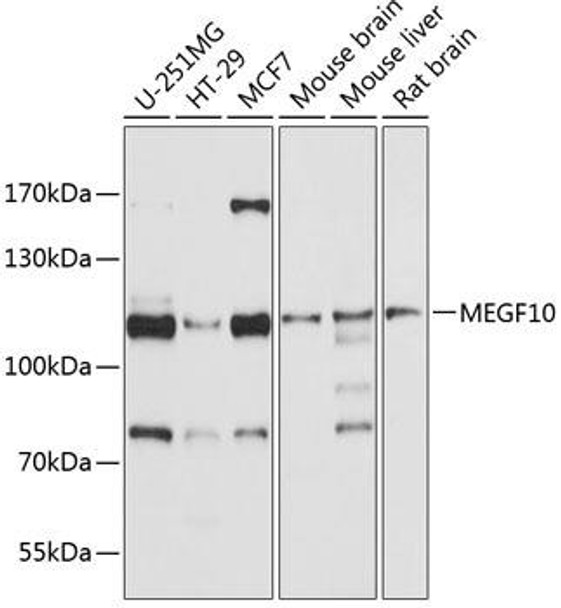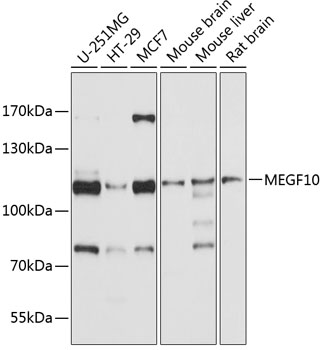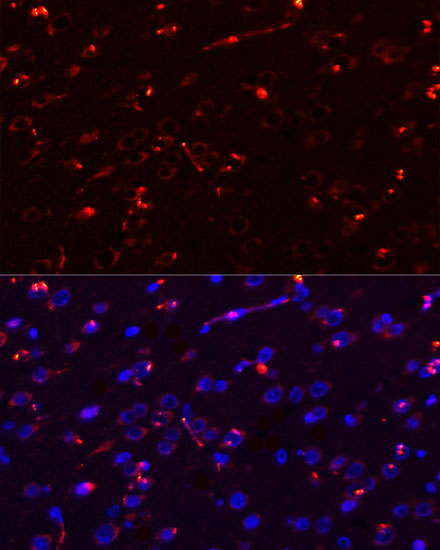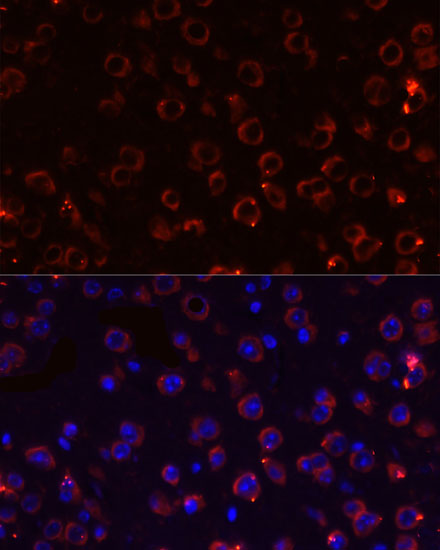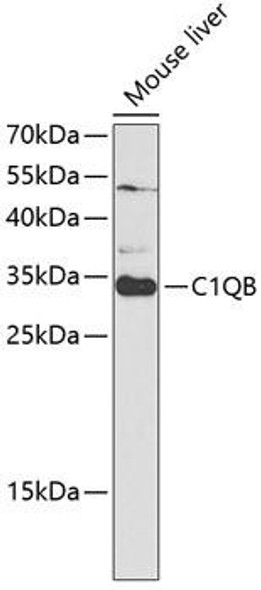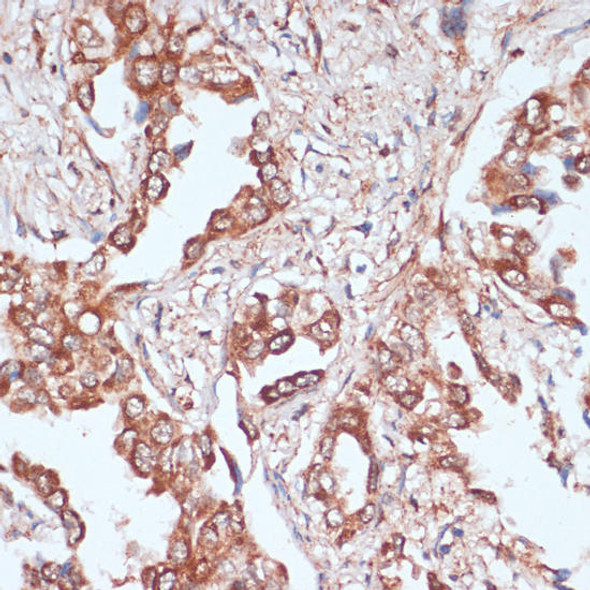Anti-MEGF10 Antibody (CAB10508)
- SKU:
- CAB10508
- Product type:
- Antibody
- Reactivity:
- Human
- Mouse
- Rat
- Host Species:
- Rabbit
- Isotype:
- IgG
- Antibody Type:
- Polyclonal Antibody
- Research Area:
- Cell Biology
Frequently bought together:
Description
| Antibody Name: | Anti-MEGF10 Antibody |
| Antibody SKU: | CAB10508 |
| Antibody Size: | 20uL, 50uL, 100uL |
| Application: | WB IF |
| Reactivity: | Human, Mouse, Rat |
| Host Species: | Rabbit |
| Immunogen: | Recombinant fusion protein containing a sequence corresponding to amino acids 26-160 of human MEGF10 (NP_001295048.1). |
| Application: | WB IF |
| Recommended Dilution: | WB 1:500 - 1:2000 IF 1:50 - 1:200 |
| Reactivity: | Human, Mouse, Rat |
| Positive Samples: | U-251MG, HT-29, MCF7, Mouse brain, Mouse liver, Rat brain |
| Immunogen: | Recombinant fusion protein containing a sequence corresponding to amino acids 26-160 of human MEGF10 (NP_001295048.1). |
| Purification Method: | Affinity purification |
| Storage Buffer: | Store at -20°C. Avoid freeze / thaw cycles. Buffer: PBS with 0.02% sodium azide, 50% glycerol, pH7.3. |
| Isotype: | IgG |
| Sequence: | LNLE DPNV CSHW ESYS VTVQ ESYP HPFD QIYY TSCT DILN WFKC TRHR VSYR TAYR HGEK TMYR RKSQ CCPG FYES GEMC VPHC ADKC VHGR CIAP NTCQ CEPG WGGT NCSS ACDG DHWG PHCT SRCQ CKNG ALC |
| Gene ID: | 84466 |
| Uniprot: | Q96KG7 |
| Cellular Location: | Basolateral cell membrane, Cell membrane, Cell projection, Single-pass type I membrane protein, phagocytic cup |
| Calculated MW: | 60kDa/122kDa |
| Observed MW: | 122kDa |
| Synonyms: | MEGF10, EMARDD |
| Background: | This gene encodes a member of the multiple epidermal growth factor-like domains protein family. The encoded protein plays a role in cell adhesion, motility and proliferation, and is a critical mediator of apoptotic cell phagocytosis as well as amyloid-beta peptide uptake in the brain. Expression of this gene may be associated with schizophrenia, and mutations in this gene are a cause of early-onset myopathy, areflexia, respiratory distress, and dysphagia (EMARDD) as well as congenital myopathy with minicores. Alternatively spliced transcript variants have been observed for this gene. |
| UniProt Protein Function: | MEGF10: Membrane receptor involved in phagocytosis by macrophages of apoptotic cells. Cooperates with ABCA1 within the process of engulfment. Promotes the formation of large intracellular vacuoles and may be responsible for the uptake of amyloid-beta peptides. May also function in the mosaic spacing of specific neuron subtypes in the retina through homotypic retinal neuron repulsion. Mosaics provide a mechanism to distribute each cell type evenly across the retina, ensuring that all parts of the visual field have access to a full set of processing elements. May play role in cell adhesion and motility. Is also an essential factor in the regulation of myogenesis. Controls the balance between skeletal muscle satellite cells proliferation and differentiation problably through regulation of the notch signaling pathway. Defects in MEGF10 are the cause of myopathy, early-onset, areflexia, respiratory distress, and dysphagia (EMARDD). An autosomal recessive congenital myopathy characterized by onset at birth, or early in infancy, of respiratory distress caused by diaphragmatic weakness. Additional features are dysphagia resulting in poor feeding, failure to thrive, poor head control, facial weakness, cleft palate, contractures and scoliosis. Affected individuals become ventilator-dependent, and most require feeding by gastrostomy. The disorder results in severe muscle weakness and most patients never achieve walking. Death from respiratory failure in childhood occurs in about half of patients. Muscle biopsy shows myopathic changes, replacement of myofibers with fatty tissue, small and incompletely fused muscle fibers, and variation in fiber size. Short regions of sarcomeric disorganization with few or no mitochondria (minicores) have been observed in some cases. Belongs to the MEGF family. 2 isoforms of the human protein are produced by alternative splicing. |
| UniProt Protein Details: | Protein type:Membrane protein, integral Chromosomal Location of Human Ortholog: 5q23.2 Molecular Function:complement component C1q binding; scavenger receptor activity Biological Process: homotypic cell-cell adhesion; muscle cell development; regulation of muscle cell differentiation; regulation of skeletal muscle development; satellite cell activation; satellite cell differentiation; satellite cell proliferation Disease: Myopathy, Areflexia, Respiratory Distress, And Dysphagia, Early-onset |
| NCBI Summary: | This gene encodes a member of the multiple epidermal growth factor-like domains protein family. The encoded protein plays a role in cell adhesion, motility and proliferation, and is a critical mediator of apoptotic cell phagocytosis as well as amyloid-beta peptide uptake in the brain. Expression of this gene may be associated with schizophrenia, and mutations in this gene are a cause of early-onset myopathy, areflexia, respiratory distress, and dysphagia (EMARDD) as well as congenital myopathy with minicores. Alternatively spliced transcript variants have been observed for this gene. [provided by RefSeq, Apr 2012] |
| UniProt Code: | Q96KG7 |
| NCBI GenInfo Identifier: | 74716908 |
| NCBI Gene ID: | 84466 |
| NCBI Accession: | |
| UniProt Secondary Accession: | Q96KG7,Q68DE5, Q8WUL3, |
| UniProt Related Accession: | Q96KG7 |
| Molecular Weight: | Calculated MW: 60kDa/122kDaObserved MW: 122kDa |
| NCBI Full Name: | Multiple epidermal growth factor-like domains protein 10 |
| NCBI Synonym Full Names: | multiple EGF like domains 10 |
| NCBI Official Symbol: | MEGF10 |
| NCBI Official Synonym Symbols: | EMARDD |
| NCBI Protein Information: | multiple epidermal growth factor-like domains protein 10 |
| UniProt Protein Name: | Multiple epidermal growth factor-like domains protein 10 |
| Protein Family: | Multiple epidermal growth factor-like domains protein |
| UniProt Gene Name: | MEGF10 |

